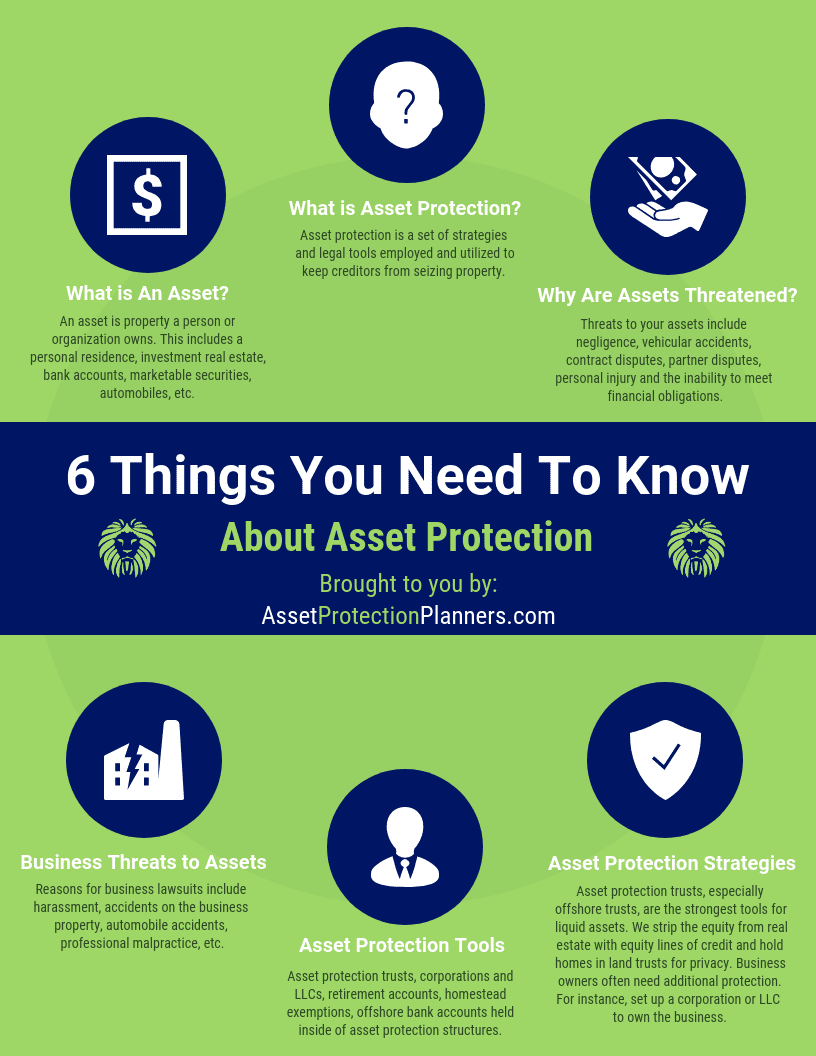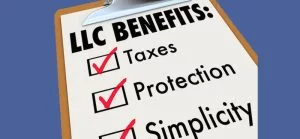If you’ve ever thought about the threats to your wealth, you’ve likely considered setting up some form of protection. However, you might not know exactly how to create an asset protection plan. If this situation sounds like the one you’re in, our team is here to help. In this article, we’ll walk you through six tips that will help you create an effective asset protection plan:
- Start Planning Before a Claim Occurs
- Create a Multi-Layered Plan
- Ensure You Understand Your Plan
- Get Insurance…But Don’t Rely on It
- Use Business Entities
- Use an Asset Protection Trust

1. Start Planning Before a Claim Occurs
The best asset protection security comes from starting early. Once you know that a lawsuit or judgment creditor is coming, some asset protection plans can still protect you. But it’s best to prepare beforehand. States have laws that protect judgment creditors against those who make asset transfers with the intent to hinder, delay, or defraud a creditor. The court will classify these late transfers as fraudulent transfers. While fraudulent transfers are a civil matter, if someone is successful in lodging one of these claims against you, it can have serious consequences. Most notably, the court can order you to reverse the transfers and turn over the assets to pay the creditor.
It’s never too early to start protecting yourself from lawsuits. Starting your asset protection plan early helps ensure that you’re protected when claims arise.

2. Create a Multi-Layered Plan
Being fully protected against creditors and lawsuits means having multiple lines of defense. It isn’t enough just to have a trust or LLC alone. The best asset protection plans create a series of obstacles for legal opponents to clear, which wears out most creditors. Of course, some plaintiffs will have the stamina and strength to try to clear those hurdles, which is when your strategically chosen tools will kick in to protect your assets.
One multi-layered strategy we recommend is using an offshore asset protection trust with an offshore LLC inside. We’ve never seen this structure fail to protect our client’s liquid assets.
Real estate is another asset that we protect using multi-layered strategies. We place real estate into land trusts for privacy of ownership. Then, for real estate other than a personal residence, we make separate LLCs the beneficiaries of each land trust to further reduce liability. Finally, we record liens against the real estate payable to an offshore entity to strip the equity from the property. If needed, we get a third-party lender to purchase the liens. The proceeds of your mortgage payments go into an untouchable account within your offshore trust.
In short, when a layered strategy is set up by a professional, lawsuits run into a brick wall of protection at the end of all the hurdles. A proper asset protection plan can protect you no matter how persistent or deep-pocketed your opponent.
You never know when a claim will arise, who it will come from, or what it will be about. That’s why it’s important to create an asset protection plan that is ready to protect against anyone.

3. Ensure You Understand Your Plan
Although your asset protection plan should have multiple layers, don’t make it more complex than needed. If you can’t explain how your asset protection plan works, then it likely isn’t a good plan. Ultimately, if you don’t understand your plan, you’ll have a hard time knowing if it’s doing its job. That is why we’ve created videos explaining how strategies to protect your assets work.
When a deposition or debtor’s examination is lodged against you, failing to clearly explain where your money is and how it got there can make the court suspicious. That alone could give the court grounds to disregard asset protection entities or set aside transfers. Though, that is easier said than done with a proper offshore asset protection plan. That said, there is a higher chance that the judge will find a case for fraudulent conveyance if they can’t understand your asset protection plan.
4. Get Insurance…But Don’t Rely on It
One line of defense in an asset protection plan is insurance. The problem is that when it comes time to make a claim, many insurance companies tuck and run. They point to exceptions in the policy as to why they should not have to pay. Plus, no matter how much insurance you have, someone can always sue you for more than your policy covers.
Insurance is best used as a hurdle for a creditor to jump over or a catch-all system for anything the rest of your plan missed. So, it is only a supplement to a plan to protect your assets and you should not rely upon it solely.
To help you better understand how you can use insurance when you create your asset protection plan, here are a few examples of common insurance policies and their applications:
- Life Insurance protects your financial contributions to your family. This insurance helps ensure that your loved ones can pay for everyday living expenses if you were to pass away unexpectedly.
- Homeowners or business insurance isn’t just about protecting your building from floods and fires. This insurance protects against lawsuits brought forth by people who are hurt on your property. Liability coverage can satisfy any court-ordered judgments as specified in your contract.
- Auto insurance should not only cover the car but also have a good amount of liability coverage. While policies with liability coverage carry higher premiums, the benefits during a lawsuit are worth the expense. A good rule of thumb is to select a policy with liability coverage equaling or exceeding the total value of your assets.
- Umbrella liability insurance covers anything that the rest of your insurance policies don’t cover. If your other insurance policies don’t cover a settlement amount, and you don’t have umbrella coverage, creditors can seize your assets and garnish your wages to make up the difference.

5. Use Business Entities
Business structures naturally divide personal property and business assets, which is invaluable for keeping assets out of creditors’ hands. Here are a few types of business structures, along with information about how they can benefit an asset protection plan:
- Limited partnerships limit your liability. As a limited partner, you are not liable for any more than what you invested in the business. Lawyers would have a hard time coming after you personally to settle a claim against your company. The downside to this entity is that you cannot take an active role in running the business. This is because you’d be considered a general partner who is fully vulnerable to business lawsuits. Thus, all assets of a general partner are fair game. That is why we make an LLC serve general partner instead.
- Corporations provide great asset protection for their owners. Except in cases of extreme fraud, someone cannot readily take your personal assets from you if your business loses a lawsuit. For tax purposes, there are two main types of for-profit corporations: S corporations and C corporations. Each has different restrictions and tax treatments, but both have similar lawsuit protection.
- Limited liability companies provide great asset protection with fewer ownership restrictions than S corporations. There is flexibility in filing for taxes as a sole proprietorship, partnership, or C or S corporation. In some jurisdictions, LLCs have charging order protection. So, even if a plaintiff latches onto your membership interest from a lawsuit, they cannot easily take your membership interest away from you. Plus, they can’t easily force a distribution of cash. Your creditor can, however, still get taxed whether they receive the payout or not. This potential outcome can help you prevent a lawsuit or settle it on favorable terms.
Two types of business entities that you best avoid are sole proprietorships and general partnerships. Sole proprietorships have no limit on personal liability. So, one mistake could create personal and professional liability. General partnerships link all partners together in a dispute. If your partner creates a legal dispute, a lawyer could come after you and your assets as well.

6. Use an Asset Protection Trust
Can a trust protect assets from a lawsuit? Yes, there are a few trusts that can give you great asset protection. One type is a domestic asset protection trust (DAPT). However, these often fail because they are under the jurisdiction of a domestic court. The other is the offshore asset protection trust (OAPT). These are powerful trusts that are immune to U.S. court rulings. The primary goal of an asset protection trust, naturally, is to protect assets from creditors and to help the settlor retain access to those assets.
Laws governing asset protection trusts vary by state and country. A typical provision for this trust type is that the grantor be a discretionary beneficiary of the trust’s income and principal. At least one trustee must be located in the state or country of origin. Some of the administration must take place there as well.
One might use this type of legal tool just for asset protection or as part of an estate plan. That is, it will direct trust assets to another beneficiary when you and/or your spouse pass away.
The domestic version won’t protect against every creditor. Depending on the state, some creditors may have access to such things as divorcing spouses and a child entitled to child support. Some will not protect from claims arising from any injury, damage, or death that the grantor caused before transferring assets into the trust. That’s where the offshore asset protection trust shines.
Get the Protection You Need
It’s never too early to create an asset protection plan. Even if you’ve already started planning, there could be more you can do to protect yourself. Ensure your plan gives you the best protection by contacting our asset protection planners today. Fill out the form below to schedule a free consultation.



